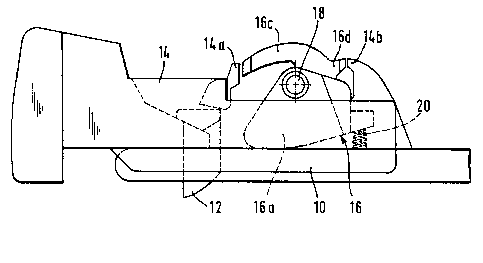Some of the information on this Web page has been provided by external sources. The Government of Canada is not responsible for the accuracy, reliability or currency of the information supplied by external sources. Users wishing to rely upon this information should consult directly with the source of the information. Content provided by external sources is not subject to official languages, privacy and accessibility requirements.
Any discrepancies in the text and image of the Claims and Abstract are due to differing posting times. Text of the Claims and Abstract are posted:
| (12) Patent Application: | (11) CA 2167253 |
|---|---|
| (54) English Title: | BUCKLE FOR SAFETY BELTS |
| (54) French Title: | BOUCLE POUR CEINTURE DE SECURITE |
| Status: | Deemed Abandoned and Beyond the Period of Reinstatement - Pending Response to Notice of Disregarded Communication |
| (51) International Patent Classification (IPC): |
|
|---|---|
| (72) Inventors : |
|
| (73) Owners : |
|
| (71) Applicants : | |
| (74) Agent: | SMART & BIGGAR LP |
| (74) Associate agent: | |
| (45) Issued: | |
| (22) Filed Date: | 1996-01-15 |
| (41) Open to Public Inspection: | 1996-07-27 |
| Examination requested: | 1996-02-29 |
| Availability of licence: | N/A |
| Dedicated to the Public: | N/A |
| (25) Language of filing: | English |
| Patent Cooperation Treaty (PCT): | No |
|---|
| (30) Application Priority Data: | ||||||
|---|---|---|---|---|---|---|
|
The pretensioner-proof buckle for safety belts has a latch
(12) which is movably mounted in a load-bearing frame (10)
between an opened position and a closed position and which
in its closed position acts on an insert tongue. A release
button (14) has a sliding mounting on the frame (10) of this
buckle, the pressing of which allows the latch (12) to be
pushed into its open position. A compensating mass forms one
arm of a lever (16) pivotally mounted on the frame. The
release button (14) has two limit stops (14a, 14b) which are
spaced from each other in the direction of their sliding
movement. The lever (16) has a first lever arm (16c), the
free end of which is located opposite the first limit stop
(14a) of the release button, and a second lever arm (16d),
the free end of which is located opposite the second limit
stop (14b) of the release button.
Note: Claims are shown in the official language in which they were submitted.
Note: Descriptions are shown in the official language in which they were submitted.

2024-08-01:As part of the Next Generation Patents (NGP) transition, the Canadian Patents Database (CPD) now contains a more detailed Event History, which replicates the Event Log of our new back-office solution.
Please note that "Inactive:" events refers to events no longer in use in our new back-office solution.
For a clearer understanding of the status of the application/patent presented on this page, the site Disclaimer , as well as the definitions for Patent , Event History , Maintenance Fee and Payment History should be consulted.
| Description | Date |
|---|---|
| Inactive: IPC from MCD | 2006-03-12 |
| Application Not Reinstated by Deadline | 1999-01-15 |
| Time Limit for Reversal Expired | 1999-01-15 |
| Inactive: Abandoned - No reply to s.30(2) Rules requisition | 1998-05-25 |
| Inactive: Status info is complete as of Log entry date | 1998-03-13 |
| Deemed Abandoned - Failure to Respond to Maintenance Fee Notice | 1998-01-20 |
| Inactive: S.30(2) Rules - Examiner requisition | 1997-11-25 |
| Application Published (Open to Public Inspection) | 1996-07-27 |
| All Requirements for Examination Determined Compliant | 1996-02-29 |
| Request for Examination Requirements Determined Compliant | 1996-02-29 |
| Abandonment Date | Reason | Reinstatement Date |
|---|---|---|
| 1998-01-20 |
Note: Records showing the ownership history in alphabetical order.
| Current Owners on Record |
|---|
| TRW OCCUPANT RESTRAINT SYSTEMS GMBH |
| Past Owners on Record |
|---|
| FRANZ WIER |